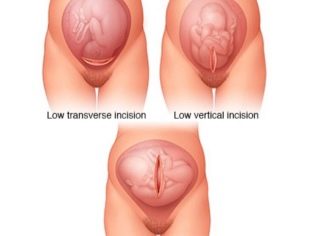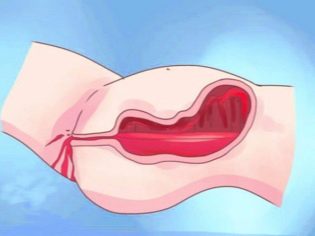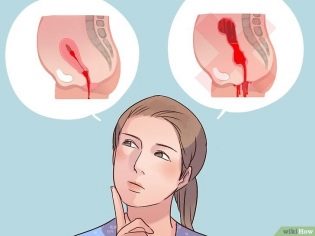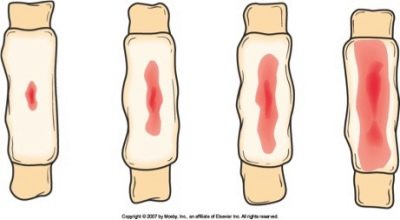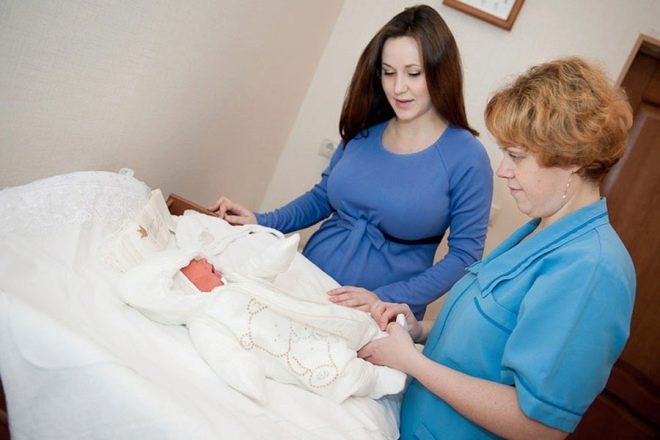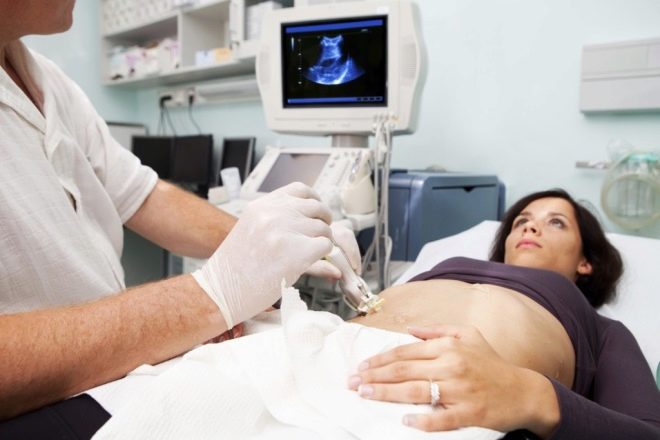How long is bleeding after cesarean section?
Every fifth birth in Russia, according to statistics, is carried out by caesarean section. Therefore, recovery issues after such an operation are important for women.
In this article, we will talk about how much time after a surgical procedure blood discharge lasts and what a woman needs to do to prevent complications.
Causes and characteristics of discharge
Postpartum discharge suggests reverse development of the female reproductive organ. The uterus during the period of carrying a child has grown 500 times, the vessels of the placenta are firmly tied up with its own blood vessels. This allowed the baby to receive the necessary nutrition and oxygen in the period of fetal development.
With surgery, the woman's uterus is injured more than with natural physiological labor. First of all, we are talking about the tissue section of the uterus itself, through which the surgeon gets access to the baby. Suturing the uterine incision is another factor to enhance the discharge after cesarean section.
The doctor separates the placenta manually after removing the baby. At the same time, the vessels connecting the “children's place” with the uterus are injured, which is the reason for the subsequent bleeding.
The enlarged uterus, when the need for such sizes disappears, begins to shrink, and in a relatively short time it will have to take almost the same size. This process also proceeds with increased secretions, which doctors call lochia.
Discharges for the doctor are a sign of inverse involution of the uterus. According to him, an experienced physician will be able to determine with great accuracy how this process is proceeding, how well recovery takes place after surgery.
In the first three days, blood usually predominates in lochia, which comes from the damaged vessels of the placenta and the wound surface in the incision area. In a laboratory study, a large number of red blood cells in the discharge is determined. Blood clots in the discharge during this period are also completely normal.
By the fifth day, the lochia begins to contain serous serum, blood. If you examine it under a microscope, you will find that the discharge contains a huge number of leukocytes, and they can also contain dead uterine epithelium cells. By the end of the first week after vaginal discharge, cervical mucus appears in the discharge. After cesarean section in the same period, particles of surgical filaments with which the incised wall of the uterus is sutured can be found in lochia. These threads are self-absorbable, but their tips, which did not enter the uterine tissue directly, are separated as the rest of the threads are resorbed and leave the uterus in the traditional way - through the vagina.
If you compare with natural childbirth, then blood in the first days after delivery surgically is much stronger. You should not be afraid of this, because the area of damage to the uterus after surgery is much larger.
Total blood loss depends on many factors - the presence or absence of complications, weight and height of the woman.
After natural childbirth, according to the BME (Big Medical Encyclopedia), a woman loses up to one and a half kilograms due to discharge of lochia and contraction of the uterus. After cesarean, this number may be higher.
Recovery time
After surgery, an early motor activation is recommended for the woman, since the faster the puerperal takes on a vertical position, the more effective the blood and clots under the action of natural gravity will depart.
After surgery, you can get out of bed after 12 hours, but this should be done gradually. Excessive zeal and careless handling of seams can lead to a discrepancy of the latter.
During the first three days, the postpartum bedding (sterile, maternity hospital) is recommended to be replaced every 3 hours. This is important not only in terms of hygienic necessity. Since the area of damage on the uterus after the operation is larger, the risk of infection is higher.
Exactly because of this reason It is not recommended to use purchased pads in the first few days - they are not sterile.
By the discharge, which occurs on the fifth day, the woman no longer has scarlet blood discharge, there are red blood cells and mucus in the lohia. Lasts a period of discharge for a long time - on average, up to 8 weeks. That is how much time is required for uterine contraction (after surgery, it shortens more slowly), as well as for healing and scarring of the incision area in the uterus.
During the first days, in order to avoid complications, women are given contraction medications. Oxytocin accelerates uterine contractions, and after the injection for 10-15 minutes, the woman may notice that the discharge has become stronger.
In addition to the control of lochia, medical workers necessarily monitor the body temperature of the puerperal, since it is her sharp rise that is sometimes the first signal of inflammation and infection. On a tour, the doctor palpates the uterus through the anterior abdominal wall, and before discharge, it is necessary to perform a control ultrasound examination, which should confirm that the uterus is clean and that the contraction occurs normally.
A small amount of blood in the urine in the absence of complaints of pain during urination during the first five days after surgery is allowed.
Norm and pathology
After discharge, the woman controls the discharge herself. Caring for a child, of course, will take a lot of time, but you should not forget about your own health.
Normal discharge is moderate, homogeneous after 2 weeks of stay at home. With normal uterus involution, after about a month and a half, the discharge becomes mucous, yellowish, and then colorless. The mucus is replaced by a normal vaginal secretion after 2 months of the recovery period.
Pathological discharge must be a reason to visit a doctor. These include the following situations:
- copious bleeding, which began suddenly after discharge from the maternity hospital, after the stage of serous lohia;
- increased bleeding or blood smear on the background of high body temperature;
- previous cessation of discharge (after 4-5 weeks);
- prolonged discharge (after 9-10 weeks after surgery);
- heterogeneity of discharge, clots, “stiffening” after discharge from the hospital;
- any abdominal pain combined with bloody discharge.
A woman in the postoperative recovery period, you need to pay special attention to the color of prominent lohi. If the discharge has become bright pink or orange, injury to the internal tissues formed in the incision area is not excluded. This can happen if a couple starts living too early. sex life, contrary to prohibitions and restrictions, if a woman will lift weights.
If the discharge has become green, gray, brownish, have an unpleasant smell, there are additional signs in the form of genital itch, be sure to be examined for infectious lesions. Yellow-green discharge may be a sign of inflammation of the endometrium. Liquid watery discharge in the recovery period is also an alarming sign, which indicates the complication of the recovery process. In any of these cases, the woman must visit the gynecologist to find the true cause of the problem and begin treatment.
How to behave - memo
Discharge after cesarean section - it is inevitable, which will have to accept.
If a woman follows the recommendations, she can easily avoid complications. This is important for the subsequent planning of pregnancy, for the preservation of reproductive and not only reproductive women's health.
Do not lift weights
For a woman who has undergone a serious abdominal surgery (and caesarean - just such an intervention), the concept of hard should change radically.
Even a child is not recommended to lift the first days after surgery, if he weighs more than 3.5 kilograms. Up to six months in the recovery process, a woman should not strain the front abdominal wall, carry bags with groceries, and lower the wheelchair with the child on the stairs. The weight allowed for lifting is no more than 4-5 kilograms.
Limit the intimate life
Until such time as Lochia is completely finished, sex is contraindicated. Such a ban is associated primarily with the probability of infection. Even conditionally pathogenic microorganisms that can enter the female genital tract in the early recovery period can cause serious health consequences. Mechanical damage to the incision area on the uterus may also occur, since during orgasm and sexual arousal the blood flow to the organ increases.
If you do not comply with this prohibition, a uterine scar can be formed insolvent, which will be a serious obstacle for carrying a subsequent pregnancy.
Watch the cycle
Since the termination of lochia, women need to use condoms to protect against the ingress of foreign microorganisms and from unplanned pregnancy. When the menstrual cycle is established (the average time for this is 2-8 months after surgery), you should consult a doctor for choosing contraceptive methods, since it is not allowed to get pregnant again for 2 years after uterine surgery.
If the lochia has just run out and followed by menstruation, it will be completely easy to distinguish them from menstruation. By the time of uterus recovery, the postpartum discharge will not be abundant and bloody, while menstruation will begin practically normal, except that there will be less clots in the discharge (due to the relative fineness of the endometrium after delivery). Monthly after the COP sometimes at first more scarce than before, but gradually their nature, duration and intensity returns to the individual indicators that were characteristic of a woman before pregnancy.
Maintain hygiene
While the postpartum discharge goes, you need to wash at least 2 times a day, change the pads 4-6 times a day (depending on the intensity of the discharge).
Douching, the use of tampons instead of gaskets after cesarean section is strictly prohibited. Also, a woman should not use vaginal suppositories, gels and creams.
This and other nuances of recovery after cesarean section, see the following video.



